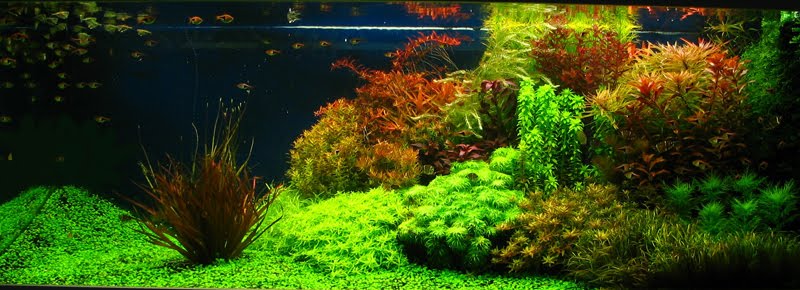Popular Aquascaping Styles
Various Aquascaping Styles and Popular Themes for Aquascape Aquarium. If you look through the Aquascaping Showcase each of the tanks are more or less based on the Nature Style or Dutch Aquascaping Style. True. These scapes are beautiful aquascapes and inspirational, but something is very wrong here. There are more than two aquascaping styles in our aquascaping world! However, let we see first how exactly the Nature aquarium style, Dutch Aquascaping and Jungle Aquascape, which is always a top choice for most aquarists.

Dutch aquascapes also feature more colorful aquatic plants. They can be likened to a well-kept formal garden, where all the plants are arranged with a purpose and kept well trimmed and defined. It may not be the most natural looking, but it is extremely beautiful and visually interesting - depending on taste. Stern plants are used in the main, so maintenance levels can be relatively high due to the amount of pruning and eventual re-planting necessary to keep the aquascape looking good. Wood and rocks are not usually used. The effective use of colours, textures and contrasts are the most important aspects to achieving success with a Dutch aquascapes.
The Nature Aquarium Style is designed to keep aquascapes simplistic and natural looking. Hardscape in Nature aquascaping style is often covered with ferns, moss and Anubias to add a sense of "age", helping to increase the natural feel to the aquascape. Stems plants are often used to add important textures and colours, although some layouts don't use any, relying on slower growing species such as ferns and crypts. These plants are ideal for long-term, low-maintenance aquascapes. The Nature aquascaping style is very popular all over the world and is also known as the Japanese style, with many variations on style and technique being implemented all the time by innovative and creative aquascapers.
Notes:
Follow each aquarists imagination. the aquascaping style in 2012 was more inspiring. Multiple streams of popular aquascape aquarium styles have its own fans. Nature, Jungle or Dutch style. Iwagumi and Taiwan aquascaping style, each has its own characteristics.
Build your own aquascaping style. One does not have to conform to any style, or blend of style, of course. Create what you like; the aquascaping possibilities are only limited by your imagination once you have mastered growing plants!
Read more »
Dutch Aquascaping style
Dutch aquariums are an older style of aquascaping, dating back to the early 20th century. The style focuses on neat rows of plants normally arranged from a central focal point, with lower plants in front and taller plants in the back, creating a sense of depth. You'll often see this described as "streets" or "avenues" using plants.
Dutch aquascapes also feature more colorful aquatic plants. They can be likened to a well-kept formal garden, where all the plants are arranged with a purpose and kept well trimmed and defined. It may not be the most natural looking, but it is extremely beautiful and visually interesting - depending on taste. Stern plants are used in the main, so maintenance levels can be relatively high due to the amount of pruning and eventual re-planting necessary to keep the aquascape looking good. Wood and rocks are not usually used. The effective use of colours, textures and contrasts are the most important aspects to achieving success with a Dutch aquascapes.
Nature Aquarium style
The term "Nature Aquarium", as an aquascape style, was conceived by the photographer, author and aquascaper, Takashi Amano in the late 1980s. The fundamental principle is that the aquascape is inspired from a scene from nature itself, whether it is from a landscape or an underwater scene. Typical Nature Aquarium compositions will have a significant quantity of hardscape like the wood and/or rocks that form the backbone of the layout, with the plants providing a vital supporting role to bring a sense of harmony and balance.The Nature Aquarium Style is designed to keep aquascapes simplistic and natural looking. Hardscape in Nature aquascaping style is often covered with ferns, moss and Anubias to add a sense of "age", helping to increase the natural feel to the aquascape. Stems plants are often used to add important textures and colours, although some layouts don't use any, relying on slower growing species such as ferns and crypts. These plants are ideal for long-term, low-maintenance aquascapes. The Nature aquascaping style is very popular all over the world and is also known as the Japanese style, with many variations on style and technique being implemented all the time by innovative and creative aquascapers.
Jungle Aquascaping style
There is no formal definition of Jungle Aquascaping style. One could say it is a blend of Dutch and Nature aquascaping styles, using some elements of both perhaps. The aquascape is typically allowed to grow untamed, giving it a wild, natural look. Although relatively "messy" when compared to some Japanese or Dutch aquascapes, the overall effect can look very attractive.Notes:
Follow each aquarists imagination. the aquascaping style in 2012 was more inspiring. Multiple streams of popular aquascape aquarium styles have its own fans. Nature, Jungle or Dutch style. Iwagumi and Taiwan aquascaping style, each has its own characteristics.
Build your own aquascaping style. One does not have to conform to any style, or blend of style, of course. Create what you like; the aquascaping possibilities are only limited by your imagination once you have mastered growing plants!

































